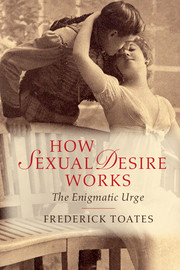Book contents
- Frontmatter
- Dedication
- Contents
- List of figures
- Preface
- One What is enigmatic about sexual desire?
- Two Explaining desire: multiple perspectives
- Three Sexual desire in a broad context
- Four An incentive-based model
- Five Sex and levels of organization
- Six Sexual attraction
- Seven Shades of desire from simple to complex
- Eight Details of the brain and desire
- Nine Arousal
- Ten The consequences of sexual behaviour and associated expectations
- Eleven Sexual familiarity and novelty
- Twelve Inhibition, conflict and temptation
- Thirteen How did sexual desire get here?
- Fourteen Setting the trajectory: link to adult sexuality
- Fifteen Sexual desire in interaction
- Sixteen Representations of sex
- Seventeen Sexual addiction
- Eighteen Variations in desire: general principles
- Nineteen Some forms of desire at the fringes
- Twenty The toxic fusion: violence and sexual desire
- Twenty one Sexually associated (serial) murder
- Twenty two Concluding remarks
- Notes
- References
- Index
Sixteen - Representations of sex
Published online by Cambridge University Press: 05 October 2014
- Frontmatter
- Dedication
- Contents
- List of figures
- Preface
- One What is enigmatic about sexual desire?
- Two Explaining desire: multiple perspectives
- Three Sexual desire in a broad context
- Four An incentive-based model
- Five Sex and levels of organization
- Six Sexual attraction
- Seven Shades of desire from simple to complex
- Eight Details of the brain and desire
- Nine Arousal
- Ten The consequences of sexual behaviour and associated expectations
- Eleven Sexual familiarity and novelty
- Twelve Inhibition, conflict and temptation
- Thirteen How did sexual desire get here?
- Fourteen Setting the trajectory: link to adult sexuality
- Fifteen Sexual desire in interaction
- Sixteen Representations of sex
- Seventeen Sexual addiction
- Eighteen Variations in desire: general principles
- Nineteen Some forms of desire at the fringes
- Twenty The toxic fusion: violence and sexual desire
- Twenty one Sexually associated (serial) murder
- Twenty two Concluding remarks
- Notes
- References
- Index
Summary
I found everything that the most voluptuous pens have written about pleasure: seductive books whose incendiary style forces the reader to seek in reality what they depict in imagination.
(Casanova, 1798/1958, p. 94)Basics
The use of representations of aspects of life is part of what it is to be human (Byrne and Osland, 2000). Representations exist outside the brain on film and paper and in its inner workings of fantasy. Our early ancestors left us cave paintings depicting hunting scenes and wild animals. In the period up to 600 bc, Etruscan art was already explicit in its depiction of heterosexual and homosexual activity (Byrne and Osland, 2000). These days we have films, the Internet, television, photographs, novels and paintings to convey other worlds to our imaginations, including those of sexuality and its possibilities.
Representations of sexuality can trigger arousal in the present as well as plans for the future and reflections upon the past. In the absence of a partner, as in masturbation, or even in their presence during sexual activity, people commonly employ ‘virtual’ means of boosting sexual excitation: erotic visual images, stories and the use of pure fantasy in the imagination (Byrne and Osland, 2000).
- Type
- Chapter
- Information
- How Sexual Desire WorksThe Enigmatic Urge, pp. 294 - 313Publisher: Cambridge University PressPrint publication year: 2014



